Science fiction paints robots as hi-tech futuristic creations, but robots (or “automatons” for those of us with a pinch of class) are much older than most of us realize. Here are just five examples.
1.
The First Robot (We Think)
Ancient literature is filled with all sorts of weird descriptions of what we would define as robots: men made of metal or wood capable of some kind of free movement. Finding the earliest references to robots is a difficult task, but the earliest actual robot we know of is easier to place: 60 AD.
A Greek engineer with the awesome name Hero built a three-wheeled wagon that both carried and controlled three “performers” for a stage show. The cart’s movement was controlled by string wrapped around the axle and weighted on the other end. Depending on which way the string was wrapped the cart could drive forwards or backwards, and could easily alternate between the two. Using a pair of strings and alternating their directions would allow for the cart to spin in a circle. The loops could be timed so that the cart could run as intricate a course as needed.
Dummies would ride on the cart fully dressed, creating a dancing robot. The string programming language was preserved in Hero’s writings and many folks have taken up the task of creating their own Hero cart. Overall it’s simple enough to be totally accessible to non-robot enthusiasts while leaving enough flexibility to make some pretty strange drive patterns.
2.
Da Vinci’s Lion
“But Weird Worm,” you say, “That’s just a wagon. You promised me a robot.” Okay you picky bastard, try this on for size: a fully functioning robot lion from the 1500s. Now before you get all technical on us (again), please note that “fully functional” in this instance does not include roaring, pouncing, man eating or any of the things that makes us both love and fear the lion. But it could walk, sway its head, open its mouth and wag its tail, which is way more than the other mechanical lions of the time could since there was only one.
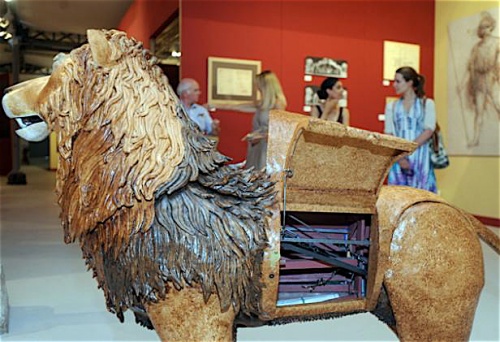
The story goes that Leonardo da Vinci built the lion for the King of France in 1515 to celebrate the new the alliance between France and Florence. A trap door in the lion would present the king with flowers, presumably because he’d need something to not freak him out after being approached by a robot lion.
Da Vinci’s lion did not survive but sketches of the movement mechanism have allowed for modern designers to take a crack at it. A hand crank (like on an old timey clock) could be wound to make the lion take ten steps. Then it would shake its head, open its mouth and wag its tail up and down.
3.
Karakuri Ningyo
What discussion of robots would be complete without a nod to Japan, everyone’s favorite eccentric uncle? Dating back to the 17th century, karakuri ningyo are best described as puppets or dolls with limited mobility. They usually were designed for entertainment by performing small tasks, a far cry from the giant robots we’ve all come to know and love.
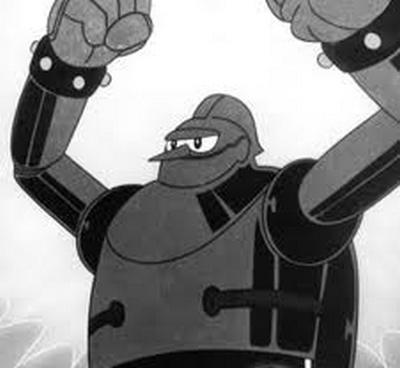
Though the resemblance is uncanny.
There were three types of karakuri ningyo: butai karakuri used in theater performances, zashiki karakuri used in the home, and dashi karakuri used for performances in religious festivals.
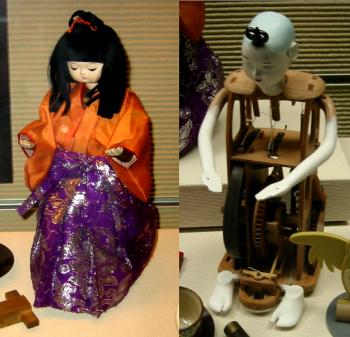
The karakuri most people are familiar with is zashiki, the tea serving robot. It worked like this: a plate with a cup of tea would be placed in the robot’s hands. The weight would make the robot’s wheels spin forward and move the machine in a straight line. Legs attached to the side or underneath would motion as though they were walking. After a short distance the robot would stop and bow its head. When the empty cup and plate were returned to its hands the robot would turn, raise its head and zip away.
4.
Jaquet-Droz Automata
The Jaquet-Droz family built many a robot in France during the 1700s, but these three take the cake. Originally constructed to advertise and boost the sale of watches, they still function today with a different purpose: to haunt your nightmares forever.
“The Musician” is a woman playing the organ. Her hands and fingers move and if you watch her chest closely enough you can see that she’s breathing. Also, you’re a pervert. Anyway, she really is playing music but the instrument isn’t an organ. It’s custom made.
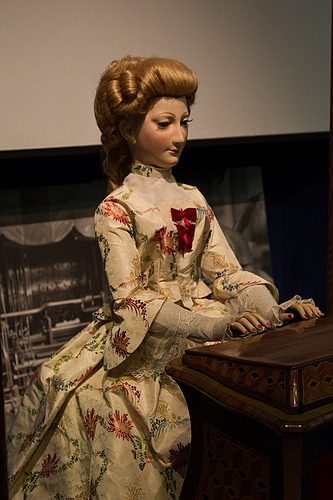
“The Draughtsman” is a small child doodling pictures. It’s actually programmed to draw four different pictures (two can be seen here). He also shifts in his chair and will occasionally blow at the tip of the pencil. A series of rotating cams control the hand’s movements.
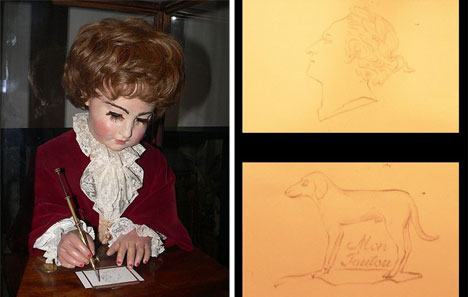
Finally, “The Writer” is a more complex version of the previous machine, this time writing a letter. What is written can be customized so long as it is only forty characters long. He will occasionally dip his pen in ink, shake his wrist to prevent spilling and his eyes will slowly follow what he writes across the page. The mechanisms are similar to those in the Draughtsman and the letters are selected with wheels.
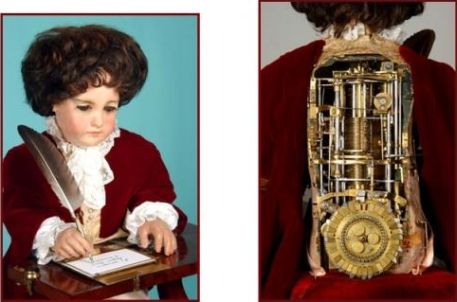
All three have survived and are currently on display at Musée d’Art et d’Histoire.
5.
Tipu’s Tiger
The exact history of Tipu’s Tiger is uncertain. What we do know is that it was built for Tipu Sultan, ruler of the Mysore Kingdom of India, sometime during the 18th century. In 1799, British soldiers decided they liked it more and took it to London. That’s pretty much it.
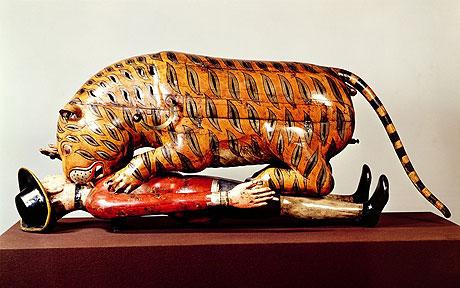
The piece itself depicts a tiger mauling a European man. The case is wooden and painted and the maul victim is close to life sized. One of the man’s hands moves in a feeble attempt to defend himself. Occasionally, the man will emit a scream-like sound and the tiger will growl. Tipu loved the device so much that the tiger became his personal symbol and he used it everywhere (short of actually feeding Europeans to tigers).
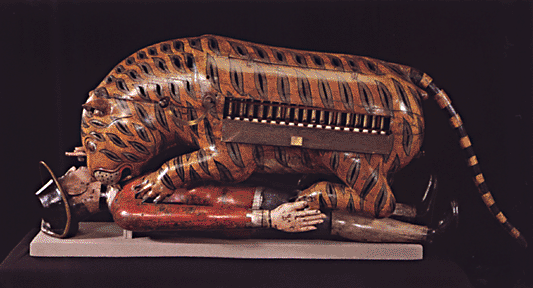
But on the off chance Tipu raised an eye brow as the screaming statue the designer included a small eighteen-note organ in the side of the tiger so you can play a jaunty tune over the screams of the damned and dying. Sadly, the organ has been reworked several times since it was taken to London and is no longer in its original form.
Written by NN – Copyrighted © www.weirdworm.net
Image Sources
Image sources:
- – Da Vinci’s Lion: http://data5.blog.de/media/911/3653911_46f23f26a9_m.jpeg
- – Karakuri Ningyo: http://t1.gstatic.com/images?q=tbn:ANd9GcThMfhUDY7xvUcisUHQElvBLNWJPx9dc_HEzhn7Aqy0JgDq5wP1K36Nu5KPkA http://www.allonrobots.com/image-files/teakarakuri.jpg
- – Jaquet-Droz Automata: http://28.media.tumblr.com/tumblr_lukly6o4lh1r1dcs8o1_400.jpg http://gajitz.com/wp-content/uploads/2011/01/the-draughtsman.jpg http://www.iaeste.ch/Trainees/Events/2009/Vineyard/ph02.jpg
- – Tipu’s Tiger: http://i.telegraph.co.uk/multimedia/archive/01453/tipu_1453889c.jpg http://www.thecityreview.com/lontiger.gif







